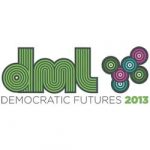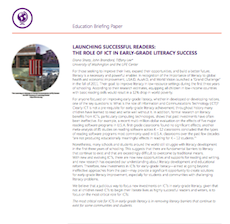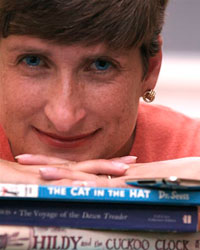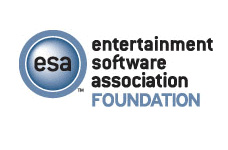Join Us at the DML Conference! Getting Global With It: Youth Global Participation in the Digital Age
 Cooney Center fellow Christina Hinton is moderating a panel at the Digital Media and Learning (DML) Conference called Getting Global With It: Youth Global Participation in the Digital Age
Cooney Center fellow Christina Hinton is moderating a panel at the Digital Media and Learning (DML) Conference called Getting Global With It: Youth Global Participation in the Digital Age
With an internationally interdependent economy, unprecedented levels of migration, and a continuous stream of information circulating the planet, children are growing up in a globalized world. In this era of globalization, children need to develop intercultural understanding. Modern digital technologies provide exciting new avenues for helping children gain this important skill. At the click of a button, children in different countries can play games together on social networking forums (SNF), have a virtual playdate through videoconferencing, or share media about their cultures on child-friendly websites. The Cooney Center at Sesame Workshop is hosting a panel at the Digital Media and Learning (DML) Conference that brings together experts from technology companies, international NGOs, and nonprofits to discuss innovative initiatives that use technology to help nurture children’s intercultural understanding. This panel, Getting Global With It: Youth Global Participation in the Digital Age, is on Thursday, March 14 11am-12:30pm in Michigan A/B.
We hope to see you there!
A Sandbox for Learning: SimCityEDU
 I’m old enough (or young enough, based on whom you ask) to have fond memories of experimenting with both SimCity 2000 and SimCity 3000, the first two sequels to Will Wright’s popular SimCity game. The ability to design and wreak havoc on my own community offered mixed feelings of power and helplessness that, as a 9-year-old, I would have had few opportunities to experiment with beyond the computer. My mother, an urban planner, would use my city’s pitfalls as a springboard to discuss broader questions of resource management and city design. So it is exciting to me that a new generation of students will be able to experience the game’s educational value in SimCityEDU.
I’m old enough (or young enough, based on whom you ask) to have fond memories of experimenting with both SimCity 2000 and SimCity 3000, the first two sequels to Will Wright’s popular SimCity game. The ability to design and wreak havoc on my own community offered mixed feelings of power and helplessness that, as a 9-year-old, I would have had few opportunities to experiment with beyond the computer. My mother, an urban planner, would use my city’s pitfalls as a springboard to discuss broader questions of resource management and city design. So it is exciting to me that a new generation of students will be able to experience the game’s educational value in SimCityEDU.
Before the release of the original game, Wright struggled for four years to find a publisher for SimCity, the first computer game which one could neither win nor lose. Fourteen years later, Wright is again redefining what computer games can do. Now SimCity and Electronic Arts, its developer, are partnering with GLASSLabs to release SimCityEDU, an online community where teachers can develop and share tools and assessments to drive STEM achievement through gameplay.
As described by its creators, “SimCity is more than a game–it is a way for the next generation of leaders to hone their skills through urban planning, environmental management and socio-economic development.” In many ways, SimCity’s open play model harnesses the same fundamentals of traditional child’s play that allow for creative learning. It creates a sandbox where users try on different roles and create their own experience. In SimCity, players don’t fail; they learn from their choices and witness tangible impacts based on their decisions. Rather than punishing students for mistakes by forcing them to start from the beginning, the game encourages players to develop more nuanced solutions based on their prior actions.
The new online community around SimCity directly targets teachers, who may be familiar with the game from their own childhood. Teachers can embed the tool into their existing curricula, with the help of Common Core-aligned lessons and assessments. They can choose to use SimCity as a short-form activity within a class period or to develop longer-term lessons to encourage deep problem solving and a greater emotional investment in one’s city. In many ways, the SimCityEDU platform is as much a sandbox as the game itself.
We are excited by EA’s contribution to the educational game space. In John Richards’ recent report, he highlighted opportunities for commercial developers to enter the educational space and argued that more commercial developers should see educational games as a new market. Rather than solely develop new tools, EA has repurposed existing content to harness its educational potential. SimCityEDU is easily adapted to a teacher’s needs, and its brand recognition may excite students who use it within an educational context. More importantly, this large-scale entry by game giant EA hopefully forecasts the entry of commercial developers into the educational game market.
What do you think about SimCityEDU. Are you an educator or parent? What impacts do you think this may have?
Running on STEAM

Still from “The Elements.”
Over the past decade, the steady increase in the accessibility of the Internet has put new technologies at the fingertips of many. This evolving platform presents a niche for the development of digital literacy and a growing market for information technologies.
With deep commitment to a mission serving the youth who need us most, my team and I at the Boys & Girls Clubs of Greater Washington (BGCGW) take on the responsibility of ensuring that every member who comes through our doors leaves with a vision for a productive life and a plan for the future. It has become a priority to equip our members with the exposure necessary to be the leaders of tomorrow’s technologies. Recently we’ve begun to focus on closing a gap in the education of some of our members, especially in the area of Science, Technology, Engineering and Mathematics (STEM). Here’s why.
In 2011, China had the highest percentage of college graduates with STEM degrees— 46.7%, followed by South Korea at 37.8%, and Germany at 28.1. The United States trails behind these economic competitors with only 5.6% of graduate degrees in STEM-related fields. After looking at these statistics, it’s hard not to consider the impact that this will have on our ability to compete in global markets, and how it can affect our national growth.
The United States Department of Labor says that 15 out of the 20 fastest growing occupations in 2014 will require significant mathematics or science preparation. According to the United States Bureau of Statistics, the country will have over 1 million job openings in STEM-related fields by 2018, and yet only 16% of United States bachelor’s degrees will specialize in STEM.
At BGCGW we use our resources not only to teach STEM, but to try and keep members engaged throughout their adolescent, pre-career years. In this pursuit we have launched STEAM, the “A” representing the arts. Examples of people who move with ease between the worlds of science and the arts have long been documented, and the integration of the arts is a powerful way to make learning fun and more meaningful. It improves student retention, helps clarify tough subjects and vocabulary, and promotes over-all learning. I encourage all of you to watch the video below to see STEAM in action.
AthleTECH and the National STEM Video Game Challenge are just two programs that promote this STEAM ideology. The visual and graphic arts components seen in popular gaming systems, such as Xbox Kinect and various software programs are unexpected secret weapons of learning comprehension.
Our goal is to get Club members involved in STEAM at an early age, create positive impact and remove any negative associations that may have already formed around these subject areas.
“Running on STEAM!” is just one of our strategies for impacting kids on their way to great futures. Find out more about our organization, our STEAM initiative and the youth we serve. Come and see what’s going on—visit a Club or check us out on Facebook and Twitter!
 Pandit F. Wright, is the president and CEO of Boys & Girls Clubs of Greater Washington (BGCGW). She is an accomplished executive whose career has included positions in leading organizations such as Discovery Communications, the number one nonfiction company in the world; premiere investment banking firm, Salomon Brothers; INCO (International Nickel Company) and Aetna.
Pandit F. Wright, is the president and CEO of Boys & Girls Clubs of Greater Washington (BGCGW). She is an accomplished executive whose career has included positions in leading organizations such as Discovery Communications, the number one nonfiction company in the world; premiere investment banking firm, Salomon Brothers; INCO (International Nickel Company) and Aetna.
Creating Solutions for Literacy Problems is Not for the Faint of Heart

“Launching Successful Readers: The Role of ICT in Early-Grade Literacy Success” by Diana Sharp, John Bransford, and Tiffany Lee. Click to download the PDF.
What really matters for early-grade reading? That’s a question we tackled in a recent paper for policy makers and other non-academic audiences, titled “Launching Successful Readers: The Role of ICT in Early-Grade Literacy Success.” Our aim was to help guide and frame discussions about how to have more effective investments in technology for early-grade literacy, in both developed and developing countries, based on research about what really matters for literacy growth.
No one disputes that many investments in technology for literacy have been ineffective at bringing about real and lasting change. At the same time, for many children and communities, literacy problems persist despite decades of trying to solve them with non-technology-based solutions. So, what’s the answer? Give up?
Of course not. We have to keep searching for solutions, and perhaps with new and evolving information and communication technologies (ICTs), there are new opportunities and supports for reading and writing, especially if we also look to the latest research on reading development and educational reform for guidance.
At this point I have to stop and admit that the idea for this paper wasn’t mine or my co-authors’ (John Bransford and Tiffany Lee at the University of Washington). Instead we’re indebted to Greg Butler, Senior Director of Microsoft’s Worldwide Education Leaders Strategy division. He proposed that one step toward helping policy makers make more effective investments for early literacy could be to help them become more informed about the research on early-grade reading. But there’s a catch, he noted: for wide readership of such a paper, it would ideally be five pages in length.
For researchers like us, that’s the kind of constraint that often makes us faint of heart. We do so prefer to be long-winded.
However, we took up the challenge, in part because we knew we could rely on excellent feedback from a group of expert reviewers from the field of reading research and from organizations such as USAID and the Joan Ganz Cooney Center. One of the conclusions of our paper is that part of the difficulty in bringing about real change for literacy outcomes is that there’s no simple answer to the question of what really matters for early-grade reading. Instead, the answer is multi-faceted, leading to multiple ways that investments designed for significant literacy change can fail:
If you want to have a real impact on children’s reading development, but you fail to support all the elements that matter, then the elements you failed to support could make your other efforts ineffective in the long run.
We agree completely with Kathleen Roskos and Susan Neuman when they wrote in a recent paper, “literacy education is not for the faint-hearted,” and we would only add that the sentiment may apply even more strongly to those who also take up the challenge of finding technological solutions, especially for communities facing difficulties for technology implementations of any kind.
And yet… we also believe that research suggests the promise for real solutions through technology is there. Does this mean that every piece of technology or software must address every aspect of what matters for early-grade reading? Not at all. But it does mean that policy makers must coordinate solutions across vendors (of both technology and non-technology solutions) to ensure that their strategy for improving early-grade reading is a comprehensive one. The strategy should include a set of solutions that will remove existing barriers to all the key factors for success in early-grade literacy, and it must also address general implementation challenges. Finally, policy makers need to include a plan for evaluating and adjusting the strategy once it is in place.
In the end, we did not meet the challenge of the five-page limit; our paper is eight pages long. But we hope it distills the research on early-grade reading with enough brevity for wide readership and enough details to help inform future conversations about more effective investments in technology for early-grade reading.
We’d love any feedback. What are the things we did not cover that policy makers really need to know about early-grade reading? What are other barriers to successful early-grade reading, and what are other barriers to making technology solutions feasible for different children and communities? We hope to learn more from the strong-hearted folks out there working toward solutions to these challenges.
Download “Launching Successful Readers: The Role of ICT in Early-Grade Literacy Success” (PDF)
Roskos, K. and Neuman, S. B. (2012), Formative assessment: Simply, no additives. The Reading Teacher, 65, 534–538. doi: 10.1002/TRTR.01079
 Diana Sharp, Ph.D., is the owner of Diana Sharp Consulting, providing consulting, development, and writing services for educational pioneers. She can be emailed here.
Diana Sharp, Ph.D., is the owner of Diana Sharp Consulting, providing consulting, development, and writing services for educational pioneers. She can be emailed here.
The Education Software Association Foundation’s Education Challenge Grant
 The Joan Ganz Cooney Center is proud to partner with the Education Software Association (ESA) Foundation on a number of initiatives, including our very own National STEM Video Game Challenge. We are especially excited about the ESA Foundation for the Education Challenge Grant, which launched this winter. The program recognizes and rewards educators who “incorporate creativity and technology in their lessons” and reflect the ways that games can make to a positive contribution to children’s learning.
The Joan Ganz Cooney Center is proud to partner with the Education Software Association (ESA) Foundation on a number of initiatives, including our very own National STEM Video Game Challenge. We are especially excited about the ESA Foundation for the Education Challenge Grant, which launched this winter. The program recognizes and rewards educators who “incorporate creativity and technology in their lessons” and reflect the ways that games can make to a positive contribution to children’s learning.
The ESA Foundation’s Education Challenge Grant invites educators to submit lesson plans, submissions and other proposals to incorporate existing computer and video games into the classroom. The Challenge Grant will award three cash prizes of up to $40,000 to the most innovative entries to be used toward implementing the proposed lesson plan.
The deadline for submissions is March 11. Learn more about the Challenge Grant and download an application on the ESA Foundation’s website.
